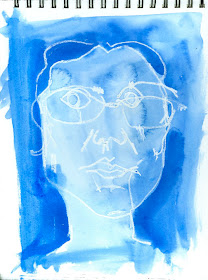In order to draw from seeing, we have to let go of any desire we you might have for the drawing to look like something. Paradoxically, that desire – that attachment to our idea of what something should look like – only gets in the way of seeing. Here is an exercise that will help you Let Go of Looking Good:
You will need:
Paper that will accept watercolor, several sheets
A white crayon
Watercolor paint, any color
Paint brush
Mirror
Cheap drawing paper or a sketchbook
Pen of your choice
1. First establish that this exercise is for your eyes only, unless you decide to share it.
2. Remember to approach the exercise with a sense of inquiry, not with a particular goal. It does not matter what the result looks like; what matters is that you approach it honestly and wholeheartedly.
3. Set up your mirror so you can see your face.
4. Slowly and carefully, draw your face with white crayon on the watercolor paper without looking at the paper. Look at your face in the mirror only. Take your time.
5. Brush water over the drawing, then paint over it in watercolor to reveal the drawing. Put it aside to dry, and repeat the process.

6. After a few blind self-portrait drawings, try a few with pen on the drawing paper or in your sketchbook, both blind and looking at your paper. Even when you are not doing a blind drawing, look more at the subject (your face in the mirror) than at the paper.
Making self portraits, for me, is one of the most effective ways of practicing letting go of looking good. This letting go not only helps you to see better, but it cultivates acceptance. Sometimes it is hard to accept how age affects how we look. We’re tempted to leave out that wrinkle or make our eyes look bigger and more youthful. Resisting this temptation not only encourages acceptance, but will result in much more beautiful and interesting drawings.

That looks like a useful exercise. Thank you for the info. I will give it a try!
ReplyDeleteGreat excercise Jane!
ReplyDeleteIt's great to see articulated what I have been "threatening" to my class that we will be doing in the next couple of weeks. I have been spending a few dollars a week to get enough standing mirrors from the dollar store to use in classes. Great exercise, great fun! Your using a white crayon with watercolor is a nice twist. We'll try it!
ReplyDeleteI like that.. no cheating. You did a great blind drawing, Jane.
ReplyDeleteLove the quirkiness and spontaneity of blind contour drawing. We all need to be reminded to stretch our boundaties. Thanks Jane.
ReplyDeletei am definitely having a go at this!!
ReplyDeletethank you for all the help and instruction :)
Thank you for this wonderful drawing series! I tried this yesterday, and it was a great exercise. I didn't have a white crayon, so used a white oil pastel instead, and painted light wash of acrylic paint on top. It looked nothing like me, but I'm going to keep practising. Thanks again! ~ Sara
ReplyDeleteThanks for your comments! This is one of my favorite exercises. White or clear oil pastel is a good resist, but will look a bit different from the crayon. Likewise, an acrylic wash will give a different result than watercolor. Experiment will all, and send me suggestions!
ReplyDeleteThe statements you made in this post have really stayed with me. Cultivating self acceptance is so important, and as usual you have expressed why in a very succinct way.
ReplyDeleteGreat practice! Couldn’t help but notice your ambidextrous? Also hear your podcast! Terrific! Thanks for all your work!
ReplyDeleteMy grade three students and six / seven classes loved doing this as a warm up before working on a project or new lesson. They faced each other and drew one another... much laughter when the reveal came!
ReplyDelete